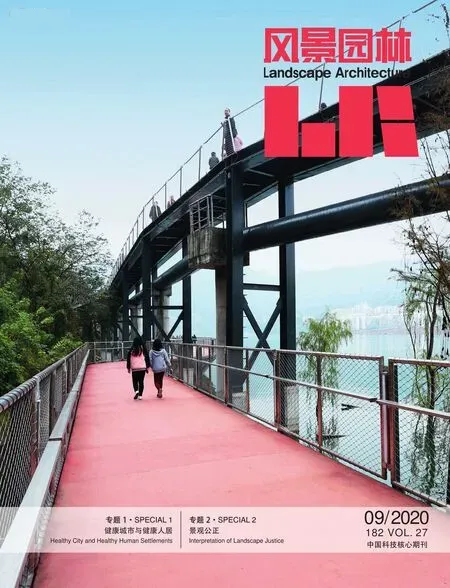新公共卫生时代的健康风景园林
20世纪初,北京的公共健康一度与西山密不可分,原因是当时的医学界普遍认为具有充足阳光、新鲜空气、丰沛矿泉、秀美风景的山地环境有助于恢复肺结核病人的抵抗力。自民国初年开始,山地康疗在北京蔚然成风,高官富贾经营山居别墅,普通民众入住天然疗养院,距离市中心最近的西山成为社会各阶层共同的疗养胜地。在西山建设别墅与疗养院的最重要推动者是李石曾,他于1917年因自身疗养之需在碧云寺内建别墅“小南园”,还分别在碧云寺和温泉村设立中法大学附属疗养院,温泉村南的显龙山随后吸引了不少社会名流来此兴建别墅。类似康疗设施还见于西山其他区域,如:1923年法国医生贝熙业在鹫峰脚下修建贝家花园;1934年静宜园内有8处民国政商人士所建造的半新式私人别墅,昭庙遗址和见心斋被用于开办香山疗养院;1935年八大处内有27处别墅和灵光寺天然疗养院;新中国成立后,上述康养设施在公有化后继续沿用,直至1976年皮内卡介苗接种和化学疗法在北京推广普及,肺结核患者不再需要住院,相关设施遂纷纷停业转产。
现代公园产生的重要初衷就是改善城市居民的健康,降低城市疫情的传播风险及其所造成的人口死亡率,为城市居民平等地提供呼吸新鲜空气、享受绿色休闲生活的自然环境。公园被看作是重要的城市公共卫生改善场所。而随着后续现代医疗水平的进步,人们开始越来越多地关注疾病治疗,研发越来越多的药物,随之公园对公共健康改善的职能也越来越少被提及和关注。
进入21世纪,新公共卫生管理理念最主要的特征就是更加关注疾病的早期预防和整体公共健康水平的提升。通过更早的干预、引导和推广健康生活方式来提高社会公众健康质量,以获得更好的基础公共健康状况。这就需要多样化社会资源的共同投入,而不再将疾病治疗单纯看作是医生的职责,许多发达国家政府公共卫生政策的重要发展趋势是将节约的公共医疗支出投入到更广阔的公共卫生条件和人居环境改善中。风景园林是拥有巨大公共卫生服务潜力的重要资源,大量的实证研究表明人们的健康离不开健康的生态系统,公园作为城市绿色基础设施可以提供绿色、舒适的户外场所,并在改善公共健康方面发挥一系列重要作用,这种改善作用涉及健康环境的营造、健康生活习惯的培育、社会交往的促进,尤其是在心理疗愈方面的价值更加显著。
目前,“公园处方”成为一种健康城市策略而流行,通过公园牵引增加居民运动量,提供放松愉悦的心理感受,辅助治疗肥胖症、心脏病、糖尿病和精神疾病等。然而,哪些风景园林要素能够提升健康效益仍不十分明确。从现代医学的发展来看,基于“证据”的预防和治疗方案制定是现代医疗实践的关键。经过一个多世纪的转变,现代医学已经发展为一门以依循证据为核心的科学,循证(Evidence-based)研究的有效性在医学的发展过程中得到了充分的体现。风景园林同样需要开展循证设计,建立与公共卫生更紧密的联系,促进改善人民健康福祉。目前的研究包括通过环境模拟,利用机器学习或数学模型进行测试,或引入虚拟现实技术(VR)为设计提供科学可靠的依据,预测不同自然场景对健康功能的影响,以及设计可能产生的环境效应,让风景园林改善公共健康的功能可以更加高效地发挥,进而将公园等绿色基础设施建设成为人、环境和经济持续平衡的绿色健康综合体。
新冠肺炎疫情等公共卫生突发事件正在重塑着全球化时代的经济、社会结构和运行方式,这种影响已从医疗体系渗透到社会生活和日常工作的方方面面,公园的价值愈发凸显出来。重建风景园林与公共卫生的紧密联系,既面向未来,亦可看作是传统的回归。拥抱新公共卫生时代的到来,促进城市人居环境和生态系统更具健康机能,这既是风景园林的机遇,更是挑战。
主编:郑曦教授
2020年8月18日
PREFACE
Landscape Architecture in the New Public Health Era
The public health of Beijing was much closely bound up with the West Mountain at the beginning of the 20th century because it was commonly accepted in the medical field at that time that a mountainous environment with plenty of sunlight, fresh air,abundant mineral springs and elegant scenery would help restore the immunity of the patients suffering tuberculosis. Since the early years of the Republic of China, mountain health therapy took prevalence in Beijing. As a result, senior of ficials and merchants rushed to run mountain villas while ordinary people were apt to live in natural sanatoriums. The West Mountain, which is the nearest to Beijing's downtown area, became an ideal health resort for people at different social classes. Li Shizeng, which played the crucial role in building villas and sanatoriums in the West Mountain, built the villa called“Xiaonanyuan” in Biyun Temple for his own need in 1917, who also established the affiliated sanatoriums of Sino-French University in Biyun Temple and Wenquan Village respectively. Subsequently, the Xianlong Mountain in the south of Wenquan Village attracted many celebrities who built their villas there. Similar health facilities could also be found in other areas of the West Mountain, such as Bei's Garden built by the French doctor Bussiere built at the foot of the Jiufeng Mountain in 1923 and the eight semi-modern private villas built by the figures in political and business circle in the Republic of China in Jingyi Resorts in 1934. The Zhaomiao Temple and Jianxinzhai Garden were used to run the Xiangshan Sanatorium.There were 27 villas and Lingguang Temple Natural Sanitarium in Badachu Resorts in 1935. All these health facilities were used continuously after the founding of People's Republic of China upon their socialization. However, these facilities finally shut down or were transferred to other industries since 1976 when the BCG vaccination and chemotherapy were popularized in Beijing so that the patients suffering tuberculosis no longer needed hospitalized treatment.
One of the original key purposes for the construction of modern parks is to improve urban citizens' health condition, lower the transmission risk of urban epidemic and the population mortality arising therefrom and provide urban residents with an equal natural environment with which, they could get access to fresh air and green leisure life. Parks are regarded as the key area for improving urban public health. With the progress of modern medical technology subsequently, people have paid more attention to disease treatment and the development of more medicines. As a result, the park's function of enhancing public health has been less mentioned and concerned.
The most prominent feature of the new public health management concept in the 21st century lies in more attention paid to the early prevention of diseases and the improvement of overall public health. The quality of the public health can be enhanced through early intervention and guiding and promoting a healthy lifestyle so as to enhance the basic public health status. The above entails the investment of diversified social resources and makes disease treatment no longer the responsibilities of doctors alone. In many developed countries, the government public health policies are apt to apply the saved public medical expenditures into the pursuit of a broader public health condition and living environment enhancement. Landscape is typically a kind of crucial resource containing huge public health service potential. A large number of empirical studies have shown that people's health largely depends on a healthy ecosystem. As urban green infrastructure, parks could provide green and comfortable outdoor place which could exert a series of effect in public health improvement that covers the creation of a healthy environment, cultivation of healthy living habits, and promotion of social communication. In particular, it could also bring a dramatic effect in psychological healing.
At present, “Park Rx” becomes very popular as a kind of strategy for pursuing a healthy urban lifestyle. With parks, residents could intensify their exercise, relax themselves and also help relieve the diseases such as obesity, heart disease, diabetes, and mental illness, etc.. However, the specific landscape architecture elements that do improve health benefits haven't been determined yet. From the perspective of modern medicine development, the formulation of “evidence” based prevention and treatment plans is critical to modern medical practice. After the transformation for more than a century, modern medicine has become a kind of evidencebased science and the effectiveness of evidence-based research has been fully reflected in the medicine development. Evidencebased design is also required by landscape architecture so as to connect public health closer and promote the improvement of people's health and well-being. Current research includes tests via environmental simulation, machine learning or mathematical models, or introduction of virtual reality (VR) technology to provide a scientific and reliable basis for design, predict the impact of different natural scenarios on health functions and the environmental effects probably caused by design. With the efforts above, landscape architecture could work better in improving public health so as to make green infrastructure such as parks a green and healthy complex where the people, environment and economy can be balanced sustainably.
Public health emergencies such as the COVID-19 epidemic are reshaping the economic and social structure and operation mode in the era of globalization. Such influence has penetrated to every aspect of the society and daily work from the medical system, and parks has brought about more prominent value. To rebuild the close relation between landscape architecture and public health is not only for the future but also means return to tradition. Embracing the upcoming new era of public health and promoting the health effect of urban living environment and ecosystems means not only an opportunity but also a challenge for the discipline of landscape architecture.
Editor-in-Chief: Professor ZHENG Xi
August 18, 2020

